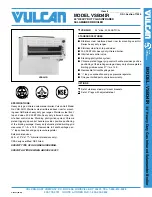
NOVA PLUS Installation & Operation Manual -
POWER FLAME INCORPORATED
DC4 DRAFT CONTROL
ENTER
ESC
®
7
10.
COMBUSTION CHAMBER – GENERAL
Certain types of heat exchangers, such as warm air furnaces, some hot oil heaters, wet base
steel, packaged firebox boilers and Scotch Marine boilers, use the combustion chamber to
transfer heat and therefore do not require refractory of other insulation. If in doubt, consult the
heat exchanger equipment manufacturer.
All possible points of air infiltration or ex-filtration must be sealed. If the unit is to be fired under
positive combustion chamber conditions, extreme care must be taken to ensure that a 100%
seal is maintained. The Model NVC burner is designed to provide all the air required for
complete and efficient combustion. Entry or loss of air from sources other than the firing unit will
decrease its’ overall combustion and operational efficiency.
Figure 4
Chamber Dimension Charts
Scotch Marine Boiler Minimum Furnace Tube Inside Diameters
BHP
Min. Inside Dimension
50
20”
100
26”
200
29”
300
34”
400
38”
500
38”
600
42”
700
45”
800
50”
900
50”
1000
50”
1200
54”
1500
54”
Note: The above dimensions are recommended minimums. If boiler dimensions are less than
indicated, consult with the factory.
Combustion chambers shall be provided as recommended,
Refer to Figure 4
, of Chamber
Dimension Charts. A minimum of six inches must be maintained around the burner element.
20
NOVA PLUS Installation & Operation Manual -
POWER FLAME INCORPORATED
DC4 DRAFT CONTROL
ENTER
ESC
®
Item
Frequency
Checked By
Remarks
Flame signal strength
Weekly
Operator
If flame signal meter installed, read and log;
for both pilot and main flames, notify service
organization if readings are very high, very low,
or fluctuating; refer to flame safeguard
manufacturer’s instructions
Pilot turndown tests
as required/annually
Service Technician
Required after any adjustments to flame
scanner mount or pilot burner; verify annually –
refer to flame safeguard manufacturer’s
instructions.
Refractory hold in
As required/annually
Service Technician
See Pilot Turndown Tests
High limit safety control
Annually
Service Technician
Refer to heat exchanger manufacturer’s
instructions
Operating control
Annually
Service Technician
Refer to heat exchanger manufacturer’s
Instructions
Low draft, fan, air pressure,
Monthly
Operator
Refer to this manual and control manufacturer’s
and damper
instructions
High & low gas pressure interlocks
Monthly
Operator
Refer to instructions in this manual
Fuel valve interlock switch
Annually
Service Technician
Refer to valve manufacturer’s instructions
Purge switch
Annually
Service Technician
Refer to fuel/air control motor manufacturer’s
instructions
Low fire start interlock
Annually
Service Technician
Refer to fuel/air control motor manufacturer’s
instructions
Automatic changeover control
At least annually
Service Technician
Under supervision of gas utility
(dual fuel)
Inspect burner components
Service Technician
Refer to this manual and control component
Manufacturer’s instructions
Check blower motor and blower
Annually
Service Technician
Remove and clean
wheel for cleanliness. Remove
and clean as necessary
Remove, inspect and clean gas
Annually
Service Technician
Remove and clean
pilot assembly
Refer to heat exchanger manufacturer’s instructions for general inspection procedures and for specific
testing and inspection of all liquid level controls, pressure/temperature relief and other applicable items.
If you have any questions about the procedures listed above or questions relating to components or
devices on your unit not specifically covered in the above, contact our Service Department at
(620) 421-0480 for assistance.
16. MAINTENANCE
General Information
Only qualified service technicians should make mechanical or electrical adjustments to the
burner and/or associated control equipment.
Preventive maintenance can usually be performed by building maintenance or operating
personnel.
Always follow the information provided in the Owner Operating Instructions on
page 26.
These
should be conspicuously posted in the burner room at the time of the initial burner installation
and startup.
Always turn the power supply off to the burner and close manual fuel valves as appropriate for
routine maintenance.
Make sure that combustion and ventilation fresh air sources to the burner room remain clean
and open.
Periodically check all electrical connections and make sure the flame safeguard control chassis
is firmly connected to its wiring base.
Refer to manufacturer’s product bulletins supplied with the burner for maintenance on the flame
safeguard control and other components.
PERIODIC CHECK LIST
Item
Frequency
Checked By
Remarks
Gages, monitors and indicators
Daily
Operator
Make visual inspection and record
Readings in log
Combustion Air Filter
Daily
Operator
Make visual inspection of filter and indicator light
Instrument and equipment
Daily
Operator
Make visual check against heat exchanger
settings
manufacturer’s recommended specifications
Firing rate control
Weekly
Operator
Verify heat exchanger manufacture’s settings
Semiannually
Service Technician
Verify heat exchanger manufacture’s settings
Annually
Service Technician
Check with combustion test
Flue, vent, stack or outlet damper
Monthly
Operator
Make visual inspection of linkage, check for
Proper operation
Combustion air
Monthly
Operator
All sources remain clean and open
Ignition System
Weekly
Operator
Make visual inspection, check flame signal
Strength if meter-fitted
(see Combustion Safety Controls)
Fuel Valves
Pilot and main
Weekly
Operator
Open limit switch-make aural and visual check
Check valve position indicators and check
Fuel meters if so fitted
Pilot & main gas
Annually
Service Technician
Perform leakage tests – refer to valve
manufacturer’s instructions
Combustion safety controls
Flame failure
Weekly
Operator
Close manual fuel supply for (1) pilot, (2) main
fuel cock, and/or valve(s) check safety
shutdown timing; log











































